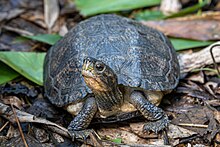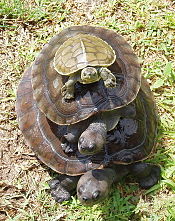| Eastern black-bridged leaf turtle | |
|---|---|

| |
| Cyclemys pulchristriata; Turtle Conservation Center, Cuc-Phuong, Vietnam | |
|
Scientific classification
| |
| Domain: | Eukaryota |
| Kingdom: | Animalia |
| Phylum: | Chordata |
| Class: | Reptilia |
| Order: | Testudines |
| Suborder: | Cryptodira |
| Superfamily: | Testudinoidea |
| Family: | Geoemydidae |
| Genus: | Cyclemys |
| Species: | C. pulchristiata
|
| Binomial name | |
| Cyclemys pulchristiata Fritz, Gaulke &
Lehr, 1997, 1997
| |

| |
| Cyclemys pulchristiata range map | |
| Synonyms [3] | |
| |
The eastern black-bridged leaf turtle (Cyclemys pulchristiata) is a species of Asian leaf turtles found in southern Indochina. [1] [4] [5]
Description
In this species, the carapace is reddish brown, ovoid to elongated, with wide, radiating, black lines or large, black specks. The plastron is mostly yellow and may have short, fat lines, specks, or be uniformly colored. The head is speckled, with a yellow throat. The neck is striped. Hatchlings have wide head and neck stripes and yellow plastrons. The bridge is predominantly yellow with black stripes or entirely black. It is mostly morphologically indistinguishable from the western black-bridged leaf turtle, C. atripons, requiring genetic sampling to confidently identify. [6] [7] Some authorities consider this species to be a junior synonym to or a subspecies of C. atripons. [3] [6]
Distribution
It is found in eastern Cambodia and in southern and central Vietnam. [1] [6] [7]
References
- ^ a b c Timmins, R.J.; Hoang, H.; McCormack, T. (2021). "Cyclemys pulchristriata". IUCN Red List of Threatened Species. 2021: e.T170508A1315477. doi: 10.2305/IUCN.UK.2021-1.RLTS.T170508A1315477.en. Retrieved 29 May 2022.
- ^ "Appendices | CITES". cites.org. Retrieved 2022-01-14.
- ^ a b Fritz Uwe; Peter Havaš (2007). "Checklist of Chelonians of the World" (PDF). Vertebrate Zoology. 57 (2): 149–368 [221]. doi: 10.3897/vz.57.e30895. Archived (PDF) from the original on 2011-05-01. Retrieved 29 May 2012.
- ^ Cyclemys pulchristiata at the Reptarium.cz Reptile Database. Accessed 29 May 2022.
- ^ Turtle Taxonomy Working Group (Rhodin, A.G.J., van Dijk, P.P, Iverson, J.B., and Shaffer, H.B.).2010. Turtles of the world, 2010 update: annotated checklist of taxonomy, synonymy, distribution, and conservation status. In: Rhodin, A.G.J., Pritchard, P.C.H., van Dijk, P.P., Saumure, R.A., Buhlmann, K.A., Iverson, J.B., and Mittermeier, R.A. (Eds.). Conservation Biology of Freshwater Turtles and Tortoises: A Compilation Project of the IUCN/SSC Tortoise and Freshwater Turtle Specialist Group. Chelonian Research Monographs No. 5. pp. 000.85–000.164, doi: 10.3854/crm.5.000.checklist.v3.2010
- ^ a b c Fritz, U.; Guicking, D.; Auer, M.; Sommer, R. S.; Wink, M. & Hundsdrfer, A. K. (2008). "Diversity of the Southeast Asian leaf turtle genus Cyclemys: how many leaves on its tree of life?" (PDF). Zoologica Scripta. 37 (4): 367–390. doi: 10.1111/j.1463-6409.2008.00332.x. S2CID 85899075.
- ^ a b Durkin, Louise; Handschuh, Markus; Sovannak, Keo; Ward, Lizzy; Hulse, Nikki; Mould, Alistair (2010). "Discovery of a hitherto unknown breeding population of the Asian leaf turtle Cyclemys aff. atripons in Phnom Kulen National Park, northwestern Cambodia" (PDF). Cambodian Journal of Natural History (1). Centre for Biodiversity Conservation, Phnom Penh.

